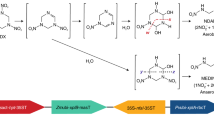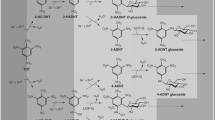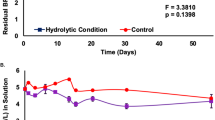Abstract
Main conclusion
Transgenic western wheatgrass degrades the explosive RDX and detoxifies TNT.
Contamination, from the explosives, hexahydro-1, 3, 5-trinitro-1, 3, 5-triazine (RDX), and 2, 4, 6-trinitrotoluene (TNT), especially on live-fire training ranges, threatens environmental and human health. Phytoremediation is an approach that could be used to clean-up explosive pollution, but it is hindered by inherently low in planta RDX degradation rates, and the high phytotoxicity of TNT. The bacterial genes, xplA and xplB, confer the ability to degrade RDX in plants, and a bacterial nitroreductase gene nfsI enhances the capacity of plants to withstand and detoxify TNT. While the previous studies have used model plant species to demonstrate the efficacy of this technology, trials using plant species able to thrive in the challenging environments found on military training ranges are now urgently needed. Perennial western wheatgrass (Pascopyrum smithii) is a United States native species that is broadly distributed across North America, well-suited for phytoremediation, and used by the US military to re-vegetate military ranges. Here, we present the first report of the genetic transformation of western wheatgrass. Plant lines transformed with xplA, xplB, and nfsI removed significantly more RDX from hydroponic solutions and retained much lower, or undetectable, levels of RDX in their leaf tissues when compared to wild-type plants. Furthermore, these plants were also more resistant to TNT toxicity, and detoxified more TNT than wild-type plants. This is the first study to engineer a field-applicable grass species capable of both RDX degradation and TNT detoxification. Together, these findings present a promising biotechnological approach to sustainably contain, remove RDX and TNT from training range soil and prevent groundwater contamination.





Similar content being viewed by others
References
Adrian NR, Arnett CM (2004) Anaerobic biodegradation of hexahydro-1,3,5-trinitro-1,3,5-triazine (RDX) by Acetobacterium malicum strain HAAP-1 isolated from a methanogenic mixed culture. Curr Microbiol 48:332–340
Ahmad F, Schnitker SP, Newell CJ (2007) Remediation of RDX- and HMX-contaminated groundwater using organic mulch permeable reactive barriers. J Contam Hydrol 90:1–20
Andeer P, Stahl DA, Bruce NC, Strand SE (2009) Lateral transfer of genes for hexahydro-1,3,5-trinitro-1,3,5-triazine (RDX) degradation. Appl Enviro Microbiol 75:3258–3262
Andeer P, Stahl DA, Lillis L, Strand SE (2013) Identification of microbial populations assimilating nitrogen from RDX in munitions contaminated military training range soils by high sensitivity stable isotope probing. Environ Sci Technol 47:10356–10363
Bernstein A, Adar E, Nejidat A, Ronen Z (2011) Isolation and characterization of RDX-degrading Rhodococcus species from a contaminated aquifer. Biodegradation 22:997–1005
Best EP, Sprecher SL, Larson SL, Fredrickson HL, Bader DF (1999) Environmental behavior of explosives in groundwater from the Milan Army Ammunition Plant in aquatic and wetland plant treatments. Uptake and fate of TNT and RDX in plants. Chemosphere 39:2057–2072
Best EP, Geter KN, Tatem HE, Lane BK (2006) Effects, transfer, and fate of RDX from aged soil in plants and worms. Chemosphere 62:616–625
Beynon ER, Symons ZC, Jackson RG, Lorenz A, Rylott EL, Bruce NC (2009) The role of oxophytodienoate reductases in the detoxification of the explosive 2,4,6-trinitrotoluene by Arabidopsis. Plant Physiol 151:253–261
Binks PR, Nicklin S, Bruce NC (1995) Degradation of hexahydro-1,3,5-trinitro-1,3,5-triazine (RDX) by Stenotrophomonas maltophilia PB1. Appl Environ Microbiol 61:1318–1322
Bolt HM, Degen GH, Dorn SB, Plottner S, Harth V (2006) Genotoxicity and potential carcinogenicity of 2,4,6-TNT trinitrotoluene: structural and toxicological considerations. Rev Environ Health 21:217–228
Brentner LB, Mukherji ST, Walsh SA, Schnoor JL (2010) Localization of hexahydro-1,3,5-trinitro-1,3,5-triazine (RDX) and 2,4,6-trinitrotoluene (TNT) in poplar and switchgrass plants using phosphor imager autoradiography. Environ Pollut 158:470–475
Christensen AH, Sharrock RA, Quail PH (1992) Maize polyubiquitin genes: structure, thermal perturbation of expression and transcript splicing, and promoter activity following transfer to protoplasts by electroporation. Plant Mol Biol 18:675–689
Coleman NV, Nelson DR, Duxbury T (1998) Aerobic biodegradation of hexahydro-1,3,5-trinitro-1,3,5-triazine (RDX) as a nitrogen source by a Rhodococcus sp., strain DN22. Soil Biol Biochem 30:1159–1167
Gandia-Herrero F, Lorenz A, Larson T, Graham IA, Bowles DJ, Rylott EL, Bruce NC (2008) Detoxification of the explosive 2,4,6-trinitrotoluene in Arabidopsis: discovery of bifunctional O- and C-glucosyltransferases. Plant J 56:963–974
Gunning V, Tzafestas K, Sparrow H, Johnston EJ, Brentnall AS, Potts JR, Rylott EL, Bruce NC (2014) Arabidopsis glutathione transferases U24 and U25 exhibit a range of detoxification activities with the environmental pollutant and explosive, 2,4,6-trinitrotoluene. Plant Physiol 165:854–865
Hannink N, Rosser SJ, French CE, Basran A, Murray JA, Nicklin S, Bruce NC (2001) Phytodetoxification of TNT by transgenic plants expressing a bacterial nitroreductase. Nat Biotechnol 19:1168–1172
Hannink NK, Subramanian M, Rosser SJ, Basran A, Murray JA, Shanks JV, Bruce NC (2007) Enhanced transformation of tnt by tobacco plants expressing a bacterial nitroreductase. Int J Phytoremediation 9:385–401
Honeycutt ME, Jarvis AS, McFarland VA (1996) Cytotoxicity and mutagenicity of 2,4,6-trinitrotoluene and its metabolites. Ecotoxicol Environ Saf 35:282–287
Jackson RG, Rylott EL, Fournier D, Hawari J, Bruce NC (2007) Exploring the biochemical properties and remediation applications of the unusual explosive-degrading P450 system XplA/B. Proc Natl Acad Sci USA 104:16822–16827
Jang IC, Choi WB, Lee KH, Song SI, Nahm BH, Kim JK (2002) High-level and ubiquitous expression of the rice cytochrome c gene OsCc1 and its promoter activity in transgenic plants provides a useful promoter for transgenesis of monocots. Plant Physiol 129:1473–1481
Johnston EJ, Rylott EL, Beynon E, Lorenz A, Chechik V, Bruce NC (2015) Monodehydroascorbate reductase mediates TNT toxicity in plants. Science 349:1072–1075
Lutz KA, Svab Z, Maliga P (2006) Construction of marker-free transplastomic tobacco using the Cre-loxP site-specific recombination system. Nat Protoc 1:900–910
Mann DG, Lafayette PR, Abercrombie LL, King ZR, Mazarei M, Halter MC, Poovaiah CR, Baxter H, Shen H, Dixon RA, Parrott WA, Neal Stewart C Jr (2012) Gateway-compatible vectors for high-throughput gene functional analysis in switchgrass (Panicum virgatum L.) and other monocot species. Plant Biotechnol J 10:226–236
Mezzari MP, Van Aken B, Yoon JM, Just CL, Schnoor JL (2004) Mathematical modeling of RDX and HMX metabolism in poplar (Populus deltoides × Populus nigra, DN34) tissue culture. Int J Phytoremediation 6:323–345
Murashige T, Skoog F (1962) A revised medium for rapid growth and bio assays with tobacco tissue cultures. Physiol Plantarum 15:473–497
Oh SY, Yoon HS, Jeong TY, Kim SD, Kim DW (2016) Reduction and persulfate oxidation of nitro explosives in contaminated soils using Fe-bearing materials. Environ Sci Process Impacts 18:863–871
Palazzo AJ, Jensen KB, Waldron BL, Cary TJ (2005) Effects of tank tracking on range grasses. J Terramechanics 42:177–191
Panz K, Miksch K (2012) Phytoremediation of explosives (TNT, RDX, HMX) by wild-type and transgenic plants. J Environ Manage 113:85–92
Pavlostathis SG, Jackson GH (2002) Biotransformation of 2,4,6-trinitrotoluene in a continuous-flow Anabaena sp. system. Water Res 36(7):1699–1706
Pichtel J (2012) Distribution and fate of military explosives and propellants in soil: a review. Appl Environ Soil Sci 2012:33
Ramasahayam S, Jaligama S, Atwa SM, Salley JT, Thongdy M, Blaylock BL, Meyer SA (2017) Megakaryocyte expansion and macrophage infiltration in bone marrow of rats subchronically treated with MNX, N-nitroso environmental degradation product of munitions compound RDX (hexahydro-1,3,5-trinitro-1,3,5-triazine). J Appl Toxicol 37:913–921
Rylott E, Bruce N (2009) Plants disarm soil: engineering plants for the phytoremediation of explosives. Trends Biotechnol 27:73–81
Rylott EL, Jackson RG, Edwards J, Womack GL, Seth-Smith HM, Rathbone DA, Strand SE, Bruce NC (2006) An explosive-degrading cytochrome P450 activity and its targeted application for the phytoremediation of RDX. Nat Biotechnol 24:216–219
Rylott EL, Budarina MV, Barker A, Lorenz A, Strand SE, Bruce NC (2011a) Engineering plants for the phytoremediation of RDX in the presence of the co-contaminating explosive TNT. New Phytol 192:405–413
Rylott EL, Jackson RG, Sabbadin F, Seth-Smith HM, Edwards J, Chong CS, Strand SE, Grogan G, Bruce NC (2011b) The explosive-degrading cytochrome P450 XplA: biochemistry, structural features and prospects for bioremediation. Biochim Biophys Acta 1814:230–236
Seth-Smith HM, Rosser SJ, Basran A, Travis ER, Dabbs ER, Nicklin S, Bruce NC (2002) Cloning, sequencing, and characterization of the hexahydro-1,3,5-Trinitro-1,3,5-triazine degradation gene cluster from Rhodococcus rhodochrous. Appl Environ Microbiol 68(10):4764–4771
Seth-Smith HMB, Edwards J, Rosser SJ, Rathbone DA, Bruce NC (2008) The explosive-degrading cytochrome P450 system is highly conserved among strains of Rhodococcus spp. Appl Environ Microbiol 74:4550–4552
Sviatenko LK, Gorb L, Leszczynska D, Okovytyy SI, Shukla MK, Leszczynski J (2017) In silico kinetics of alkaline hydrolysis of 1,3,5-trinitro-1,3,5-triazinane (RDX): M06-2X investigation. Environ Sci Process Impacts 19:388–394
Thompson KT, Crocker FH, Fredrickson HL (2005) Mineralization of the cyclic nitramine explosive hexahydro-1,3,5-trinitro-1,3,5-triazine by Gordonia and Williamsia spp. Appl Environ Microbiol 71:8265–8272
Travis ER, Bruce NC, Rosser SJ (2008) Short term exposure to elevated trinitrotoluene concentrations induced structural and functional changes in the soil bacterial community. Environ Pollut 153:432–439
Tzfira T, Tian GW, Lacroix B, Vyas S, Li J, Leitner-Dagan Y, Krichevsky A, Taylor T, Vainstein A, Citovsky V (2005) pSAT vectors: a modular series of plasmids for autofluorescent protein tagging and expression of multiple genes in plants. Plant Mol Biol 57:503–516
United States Department of Agriculture (2002) Plant fact sheet-western wheatgrass (Pascopyrum smithii) https://plants.usda.gov/factsheet/pdf/fs_pasm.pdf
United States Environmental Protection Agency (2014) Technical fact sheet –hexahydro-1,3,5-trinitro- 1,3,5-triazine (RDX) https://www.epa.gov/sites/production/files/2014-03/documents/ffrrofactsheet_contaminant_rdx_january2014_final.pdf and technical fact sheet—2,4,6-trinitrotoluene (TNT) https://www.epa.gov/sites/production/files/2014-03/documents/ffrrofactsheet_contaminant_tnt_january2014_final.pdf
United States General Accounting Office (2004) Department of Defense operational ranges, more reliable cleanup cost estimates and a proactive approach to identifying contamination are needed. http://www.dtic.mil/cgi-bin/GetTRDoc?AD=ADA435939&Location=U2&doc=GetTRDoc.pdf
Van Aken B, Yoon JM, Just CL, Schnoor JL (2004) Metabolism and mineralization of hexahydro-1,3,5-trinitro-1,3,5-triazine inside poplar tissues (Populus deltoides × nigra DN-34). Environ Sci Technol 38:4572–4579
Via SM, Zinnert JC (2016) Impacts of explosive compounds on vegetation: a need for community scale investigations. Environ Pollut 208:495–505
Via SM, Zinnert JC, Young DR (2015) Differential effects of two explosive compounds on seed germination and seedling morphology of a woody shrub, Morella cerifera. Ecotoxicology 24:194–201
Vila M, Lorber-Pascal S, Laurent F (2007) Fate of RDX and TNT in agronomic plants. Environ Pollut 148:148–154
Winfield LE, Rodger JH, D’surney SJ (2004) The responses of selected terrestrial plants to short (< 12 days) and long term (2, 4 and 6 weeks) hexahydro-1,3,5-trinitro-1,3,5-triazine (RDX) exposure. part I: Growth and developmental effects. Ecotoxicology 13:335–347
Xiong RC, Fern JT, Keffer DJ, Fuentes-Cabrera M, Nicholson DM (2009) Molecular simulations of adsorption and diffusion of RDX in IRMOF-1. Mol Simulat 35:910–919
Yoon JM, Van Aken B, Schnoor JL (2006) Leaching of contaminated leaves following uptake and phytoremediation of RDX, HMX, and TNT by poplar. Int J Phytoremediation 8:81–94
Zhang L, Routsong R, Nguyen Q, Rylott EL, Bruce NC, Strand SE (2017a) Expression in grasses of multiple transgenes for degradation of munitions compounds on live-fire training ranges. Plant Biotechnol J 15:624–633
Zhang L, Rylott EL, Bruce NC, Strand SE (2017b) Phytodetoxification of TNT by transplastomic tobacco (Nicotiana tabacum) expressing a bacterial nitroreductase. Plant Mol Biol 95:99–109
Acknowledgements
The authors declare no conflict of interest. This work was funded by US DoD SERDP ER-1498 and ESTCP ER-201436. We thank Mr. Ryan Routsong for his work of maintaining the HPLC system and advice for preparing HPLC samples.
Author information
Authors and Affiliations
Corresponding author
Electronic supplementary material
Below is the link to the electronic supplementary material.
Rights and permissions
About this article
Cite this article
Zhang, L., Rylott, E.L., Bruce, N.C. et al. Genetic modification of western wheatgrass (Pascopyrum smithii) for the phytoremediation of RDX and TNT. Planta 249, 1007–1015 (2019). https://doi.org/10.1007/s00425-018-3057-9
Received:
Accepted:
Published:
Issue Date:
DOI: https://doi.org/10.1007/s00425-018-3057-9




